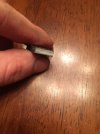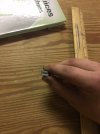- Joined
- Nov 14, 2016
- Messages
- 636
Hey guys, so I figured I would start doing some testing on normalizing then quenching vs. normalizing followed by grain refinement cycles then quenching. I wanted to test the difference between cutting performance on a larger grain vs refined grain.
I do grain refinement cycles on my knives to 1350. The one I left at normalizing temp was 1650 then quenched.
I haven't started testing the two yet. I wanted to ask you guys how much of a difference grain refinement will matter on a bowie. What should I be looking for when I test. Edge retention and sharpness? Should the grain refined knife outperform the other very obviously or will it be very subtle?
I also quenched little pieces of w2 and broke them to see the difference. I lost the refined grain piece but here is the only normalized piece and then quenches at 1440



What can you guys tell me about this grain. I have seen some people only normalize steel and then quench without thermal cycling. Is this grain size acceptable or would it be complete crap?
I would never sell a knife without grain refinement cycles. Just curious what your thoughts are on this grain to further my knowledge
Tell me what you guys think or any personal experiences with testing!
thanks guys!
I do grain refinement cycles on my knives to 1350. The one I left at normalizing temp was 1650 then quenched.
I haven't started testing the two yet. I wanted to ask you guys how much of a difference grain refinement will matter on a bowie. What should I be looking for when I test. Edge retention and sharpness? Should the grain refined knife outperform the other very obviously or will it be very subtle?
I also quenched little pieces of w2 and broke them to see the difference. I lost the refined grain piece but here is the only normalized piece and then quenches at 1440



What can you guys tell me about this grain. I have seen some people only normalize steel and then quench without thermal cycling. Is this grain size acceptable or would it be complete crap?
I would never sell a knife without grain refinement cycles. Just curious what your thoughts are on this grain to further my knowledge
Tell me what you guys think or any personal experiences with testing!
thanks guys!
